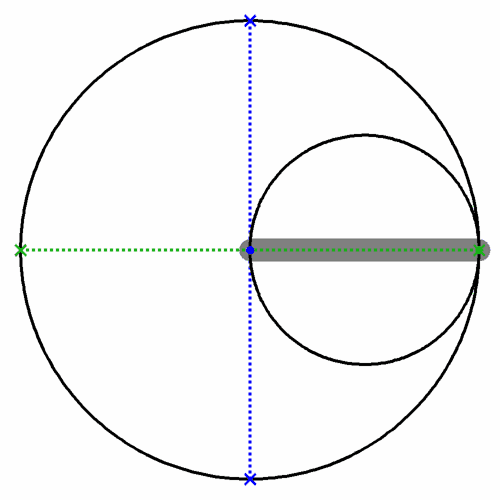
Caption: The Tusi couple (see the animation to the right) is a mathematical device in which a smaller circle (of radius r) rotates around its center while its center rotates (with radius r) around the center of a larger circle twice the diameter of the smaller circle. The compounded motions of the smaller circle cause a point on the circumference of the smaller circle to undergo a sinusoidal oscillation along a diameter of the larger circle. The Tusi couple is a 2-cusped hypocycloid.
Note that along a diameter of any orientation, there will be a sinusoidal oscillation of a some point on the smaller circle. This result follows from symmetry. The animation shows explicitly the sinusoidal oscillations along the x-axis and the y-axis.
Features:
- The Tusi couple
was first introduced in the 13th century
by Nasir al-Din al-Tusi (1201--1274)
(a Persian
polymath:
architect,
astronomer,
mathematician,
philosopher,
physician,
scientist,
theologian) in his
Tahrir al-Majisti = Commentary on the Almagest (1247)
as a model for the
latitudinal motion
of the
inferior planets.
It was later often used as a replacement for the
equant introduced
by Ptolemy (c.100--c.170 CE) in
the Almagest.
The equant
was the
crime of Ptolemy since
it violated the principle of
uniform circular motion
which was usually posited as essential by
Greek astronomy
and by Ptolemy himself.
- The term Tusi couple is modern
and was introduced by
science historian
Edward Stewart Kennedy (1912--2009)
in 1966.
- Nicolaus Copernicus (1473--1543)
made use of the
Tusi couple
in his planetary models in his
De Revolutionibus Orbium Coelestium
= On the Revolutions of the Heavenly Spheres (1543).
It is NOT known how Copernicus knew of the Tusi couple. There are 3 possibilities:
- Some more or less complicated transmission path from Nasir al-Din al-Tusi.
- Some more or less complicated transmission path from some unknown independent discoverer.
- Copernicus may have discovered the Tusi couple for himself---it's not rocket science.
- The transformation of
rotation
(AKA rotary motion)
to
sinusoidal oscillation
(in technology
jargon,
reciprocating motion)
and vice versa
is an important ingredient
in technology.
For example, the
internal combustion engine (ICE)
works by converting the
reciprocating motion
of a piston
in an engine cylinder
into the
rotation
of car
wheels.
See the figure below
(local link /
general link: internal_combustion_engine.html).
Yours truly CANNOT think of any exact realization of the Tusi couple in technology.
- EOF
Image link: Wikimedia Commons: File:Tusi couple vs Paper strip.gif.
Local file: local link: tusi_couple.html.
File: Copernicus file: tusi_couple_4.html.
File: Copernicus file: tusi_couple.html.